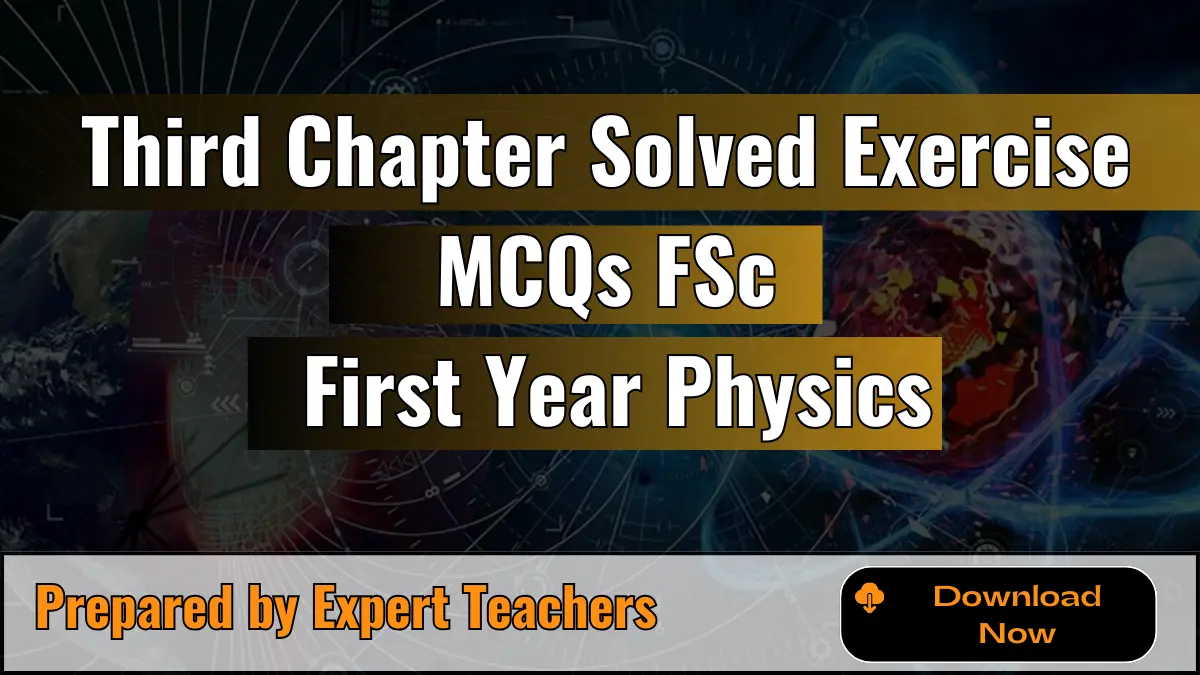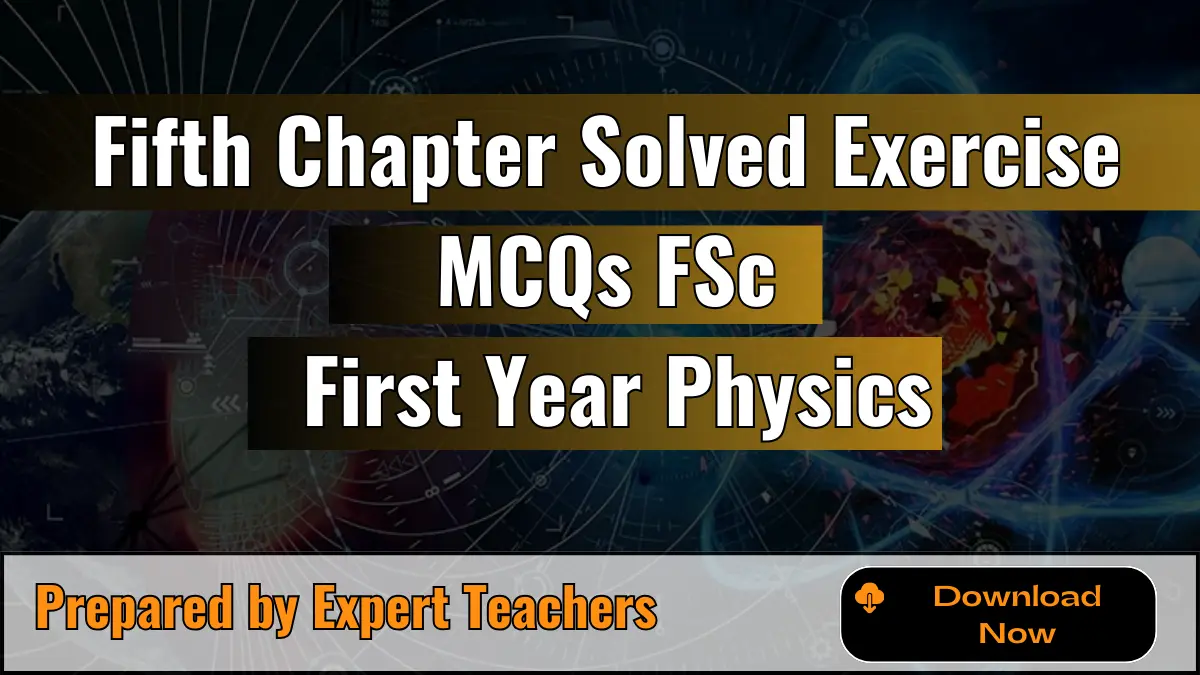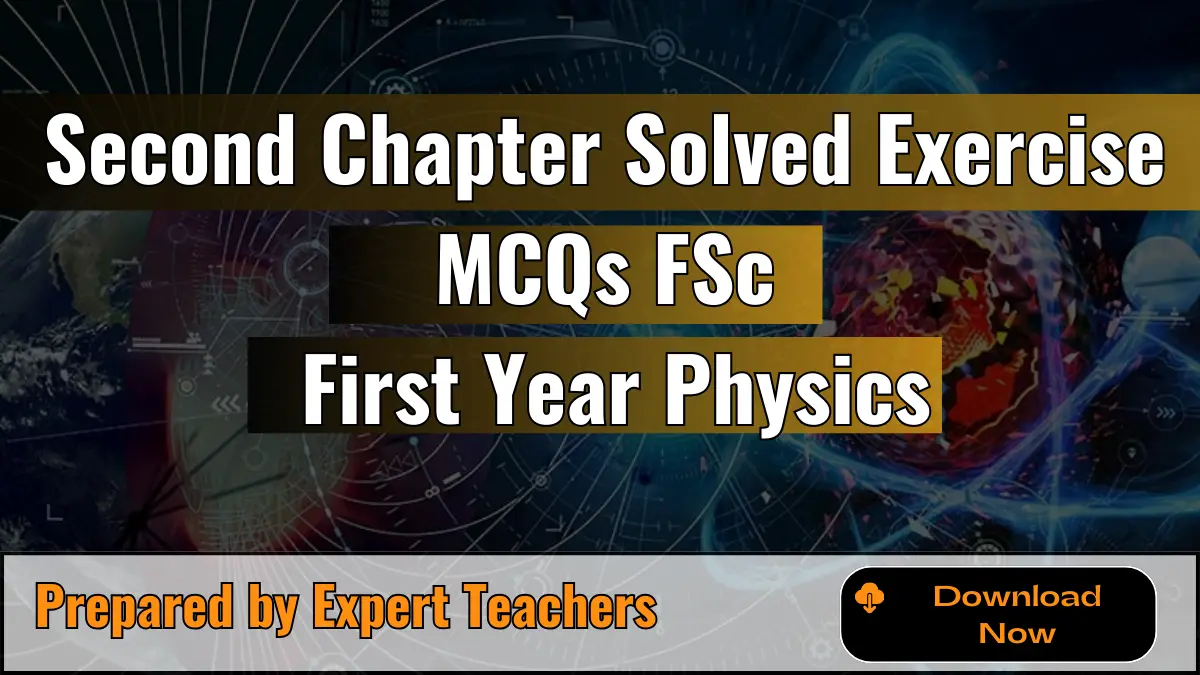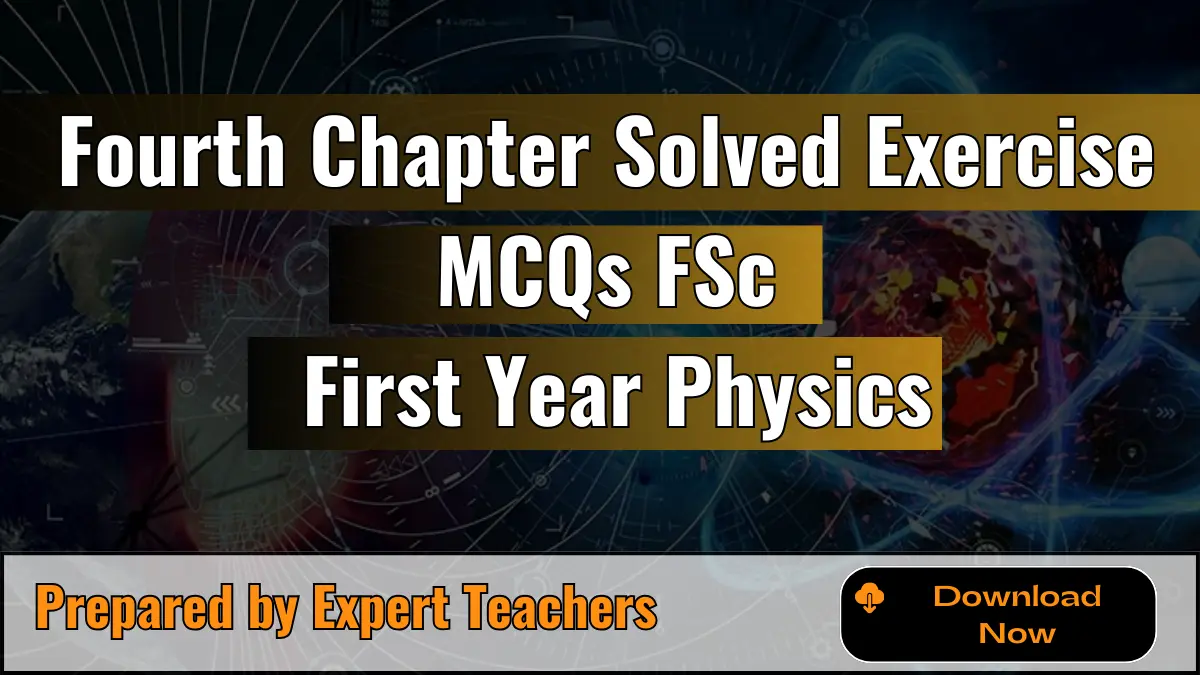First Chapter Solved Exercise MCQs Of FSc First Year Physics
First Chapter Solved Exercise MCQs of FSc First Year Physics is helpful for FSc students. It includes multiple-choice questions from the first chapter, each with a clear answer and explanation. This resource is perfect for reviewing key ideas, practicing for exams, and improving understanding of physics concepts.
First chapter solved MCQs with explanation
- The main frontiers of fundamental sciences are
(a) One
(b) Two
(c) Three
(d) Four
Explanation: The correct answer is (d) Four. Fundamental sciences encompass a vast range of disciplines, including physics, chemistry, biology, astronomy, and more. Each field explores distinct aspects of the universe, with their frontiers and unanswered questions.
2. The branch of physics which deals with the ultimate particles of which the matter is composed is called
(a) Plasma physics
(b) Nuclear physics
(c) Particle physics
(d) Solid state physics
Explanation: Correct Answer is (c) Particle physics. Particle physics focuses on studying the fundamental constituents of matter and their interactions, including subatomic particles like quarks and leptons.
3. Which one of the following is not a unit of energy?
(a) Kilowatt
(b) Erg
(c) Joule
(d) Kilowatt hour
Explanation: The Correct answer is (d) Kilowatt hour. Kilowatt hour (kWh) is a unit of energy consumption over time (power × time). Joule (J), erg, and kilowatt (kW) are all units of energy itself.
4. Steradian is the unit of
(a) Plane angle
(b) Solid angle
(c) Temperature
(d) Intensity of light
Explanation: The Correct answer is (b) Solid angle. Steradian (sr) measures a solid angle, which is a three-dimensional angular wedge representing a portion of a sphere’s surface area.
5. Which one of the following is a base quantity?
(a) Area
(b) Charge
(c) Current
(d) Force
Explanation: The Correct answer is (d) Force. Base quantities are fundamental and independent, forming the basis for derived quantities. Force is derived from mass, length, and time. Area is also a derived quantity (length × length).
6. If p is the momentum of an object of mass m, the expression p2/2m has base units identical to
(a) Energy
(b) Force
(c) Power
(d) Velocity
Explanation: The Correct answer is (a) Energy. Momentum (p) is mass (m) times velocity (v). p2/2m = (mv)2 / 2m = (1/2)mv2, which has the same units as kinetic energy (Joules).
7. By increasing the number of observations in an experiment, the error in measurement:
(a) Increases
(b) Decreases
(c) Remains same
(d) None of these
Explanation: The Correct answer is (b) Decreases.More observations generally lead to a more accurate average value, reducing the random error associated with individual measurements.
8. How many significant zeros are there in 0.00050107?
(a) 3
(b) 4
(c) 2
(d) 6
Explanation: The Correct answer is (c). Zeros between non-zero digits and the decimal point are significant. The trailing zero after the ‘7’ is significant because it indicates a measurement to the ten-thousandth place.π
9. Error in the measurement of radius of sphere is 1%. The error in the calculated value of its volume is:
(a) 7%
(b) 5%
(c) 3%
(d) 1%
Explanation: The Correct answer is (c). For spheres, volume is proportional to radius cubed (V ∝ r^3). A 1% error in radius leads to an approximate 3% error in volume due to the power of 3.
10. The percentage errors in the measurement of mass and speed are 2% and 3%, respectively. The maximum error in the calculation of K.E. will be:
(a) 1%
(b) 5%
(c) 8%
(d) 11%
Explanation: The Correct answer is (b). Error propagation dictates that the maximum error in a calculation involving multiple quantities is approximately the sum of the individual percentage errors (assuming uncorrelated errors). Here, 2% + 3% ≈ 5%.
11. How many significant zeros are there in 5.00 × 10^-3?
(a) 3
(b) 4
(c) 2
(d) 6
Explanation: The Correct answer is (a). Zeros to the right of the decimal point and behind the trailing non-zero digit (5) are significant because they indicate measurement to a specific decimal place.
12. Zero error is the example of:
(a) Personal error
(b) Random error
(c) Systematic error
(d) All of these
Explanation: The Correct answer is (c).Zero error is a constant bias that consistently affects all measurements in the same direction. It’s a systematic error, unlike random errors that vary from measurement to measurement.
13. Poor calibration is an example of:
(a) Personal error
(b) Random error
(c) Systematic error
(d) None of these
Explanation: The correct answer is (c). Poor calibration introduces a consistent bias in measurements, making it a systematic error.
14. √ (F × l / m) has the dimensions of:
(a) Velocity
(b) Acceleration
(c) Momentum
(d) None of these
Explanation: The correct answer is (a) Velocity. The dimensions of force (F) are ML⁻¹T⁻². The dimensions of length (l) are L. The dimensions of mass (m) are M. Therefore, the dimensions of the expression √ (F × l / m) are: √ (ML⁻¹T⁻² × L / M) = √ (L²T⁻²) = LT⁻¹ The dimensions LT⁻¹ are the same as the dimensions of velocity, which is defined as the rate of change of displacement with respect to time.
15. The unit of energy is _____ and its unit symbol is _____.
(a) Joule, j
(b) Joule, J
(c) joule, J
(d) joule, j
Explanation: The correct answer is (c) joule, J. The unit of energy is joule and its unit symbol is J.
16. The dimension of light year are:
(a) [LT^-1]
(b) [M^0L^0T]
(c) [ML^2T^-2]
(d) [M^0LT^0]
Explanation: The correct answer is (d) [M^0LT^0]. Light-year is a unit of distance, not a physical quantity with dimensions of mass, length, or time. Therefore, it has dimensions of [M^0LT^0].
17. Which one of the following is not dimensionally correct equation?
(a) E = mc^2
(b) v_t = v_l + at
(c) S = vt^2
(d) S = (1/2)at^2
Explanation: The correct answer is (c) S = vt^2. The left side (S) has dimensions of length ([L]), while the right side (vt^2) has dimensions of length times time squared ([L][T]^2). These dimensions are not consistent.
18. The gravitational constant G has dimensions:
(a) [ML^2T^-1]
(b) [M^0L^0T]
(c) [ML^2T^-2]
(d) [M^0LT^0]
Explanation: The correct answer is (a) [ML^2T^-1].The gravitational force law (F = Gm1m2/r2) gives the dimensions of G as [ML^2T^-2] / [M^2] = [ML^2T^-1].
19. Which of the following has the same dimensions as that of momentum?
(a) Force
(b) Energy
(c) Stress
(d) Impulse
Explanation:The correct answer is (d) Impulse. Impulse is defined as the change in momentum, so it has the same dimensions as momentum ([MLT^-1]).
20. SI unit of light year is:
(a) Meter
(b) Candela
(c) Second
(d) None of these
Explanation: The correct answer is (a) Meter: A light-year is a unit of distance, and the SI unit of distance is the meter (m).







Leave a Reply